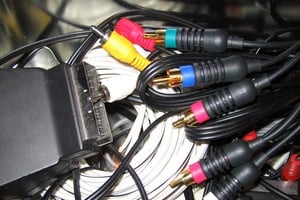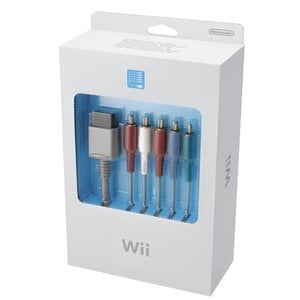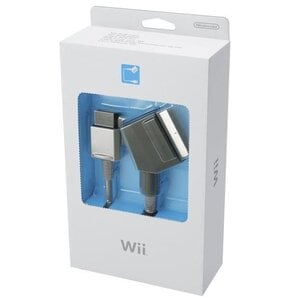
Much like the world of computers, the abyss that is AV can be just as confusing. We're going to take you though both audio and video standards and give you an idea of what does what.
Video
Display technology has exploded over the past 5 years, you'd be living under a rock if you hadn't noticed the flood of LCD and Plasma screens onto the market. CRT is pretty much dead in terms of modern TVs.
Both LCD and Plasma are flat screen technologies, meaning the screen is often only an inch or so in depth, gone are the days of a huge TV set mounted on a stand. These modern screens can be mounted on the wall, stand or even a wall bracket. The actual display is the same as modern computer TFT monitors, its basically a huge array of pixels, each pixel displaying a single block of colour, much like your old Gameboy screen, just one hell of a lot more dots.
Subscribe to Nintendo Life on YouTube841k

High Definition
You've also probably heard the terms “HD Ready”, “HDTV” or “High Definition”. One of the advantages of these new displays having SO many pixels its possible to display a much more detailed picture than previous CRT based screens. Pretty much all LCD/Plasma screens will be “HD Ready” meaning they are capable of receiving High Definition signals.
HDTV typically comes in four flavours, 1080p, 1080i, 720p and 480p (Okay, technically 480p is EDTV, but we're trying to keep this simple). What the hell do those numbers mean? Actually its quite simple, the number referrers to the number of vertical lines contained in the signal and the p/i referres to the signal being Progressive or Interlaced.

The more vertical lines the signal has, the more detail it can contain. For example, 480p would be a resolution of 720x480 = 345,600 pixels where 1080p would be a resolution of 1920x1080 = 2,073,600 pixels. Obviously the signal with the most pixels can contain the most detail.

You can find a more detailed description of HDTV over at Wikipedia.
Progressive Scan
Traditionally television screens display their picture in an “interlaced” method. Interlacing is the process of taking an picture signal and removing either all the odd lines or all the even lines and therefore reducing the bandwidth by half. Progressive scan basically means this process hasn't taken place and can simply be referred to as non-interlaced.
The best example is the graphic below, on the left we have an image that display's all lines from the original signal, in the middle we have a basic interlaced signal, which takes half of the lines and on the right, we have an interlaced signal with anti-aliasing (which tries to smooth the edges).

To put it simple, interlacing a signal removes half of the picture so progressive scan should give a much cleaner picture and removes any flickering. You can also find out more information about this topic over on Wikipedia.
Component
When it comes to your Wii, component cable is the best possible signal you can use. The signal is broken into 3 known as YPbPr, Y carries luminance information, Pb carries the difference between blue and luminance and Pr carries the difference between red and luminance.
Component is the standard analogue system used for HD signals such as 480p, 720p, 1080i etc. Component cables are usually made up of 3 coloured phono connectors, coloured Red, Green and Blue. They are usually accompanied by a further set of Red and White phono connectors that are used for the audio.
You'll find component connectors on most decent flat screen televisions and also in some older high end CRT sets. Although Component has been popular for years, it is being super-seeded by its digial rivals DVI and HDMI, but you only need to worry about these if your getting a PS3.
If you want the best from Wii, component is the cable to use.
RGB Scart
Another way of representing the video signal is RGB Scart, this has been the most popular cable in Europe for quite some time. It delivers a sharp picture with deep colours, but lacks any capability of high definition. RGB Scart works on a different principle to component, it simply carries the Red, Green and Blue signals followed by a V-Sync signal which basically syncs everything together.
Scart sockets are those big chunky ones that you can never seem to connect right! If you don't own a flat screen tv, this is the connection for you. The scart socket consists of 21 pins and carries both audio and video.
Composite
Composite is the bog standard cable that comes with your Wii, its the very simple 3 phono affair, Yellow is the video signal, Red and White for audio.
Composite is well known for being pretty horrible in terms of picture quality, colour contrast is often blurred with fuzzy lines and colours can seem washed out.
Pretty much all modern TV's with scart sockets will support RGB Scart, so we'd strongly suggest you ditch the standard cable and get one of the above!
Please note, connecting your composite cable into a “Scart Adapter” does not mean you'll be seeing a RGB Scart signal on screen, sorry folks.
Audio
Sadly the audio options for Wii are very simple, your going to be using the classic twin phono cables, white/black for left and red for right. With no form of digital connector, Wii won't support the wonders of Dolby Digital EX or Dolby True HD.
Instead Nintendo have opted to renew its support of the Pro Logic II format. Basically Pro Logic II uses existing analogue signals and tries to “embed” a 5.1 signal inside it, if your audio receiver supports it, it can decode the signal and separate out the audio channels for the different speakers, if not then you just get the usual stereo effect. It tries to bridge the gap between old and new.
Not to be too negative on Nintendo, but I was really disappointed that Dolby Digital 5.1 wasn't included for the Wii, hearing the difference between Pro Logic II and Dolby Digital is in a totally different league. Oh Well.
Conclusions
Although the Wii isn't the most advanced when it comes to AV, buying the right cable for the display can really make the difference. Remember to bag yourself a Component cable if you have a HD screen, otherwise a RGB Scart is highly recommended.
If we've not covered something or you simply have a question, please feel free to ask, we're here to help!

Comments 13
Fantastic work Ant! That covers pretty much every question I was going to perter you about
I use my 20" Dell Widescreen computer display for video games too (I do not own a TV and am not planning on buying one). It has the following connections: DVI, VGA, S-Video and Composite. The best way to connect the Wii directly with a cable would be S-Video, which has been announced at least for Japan.
But how about displaying a component signal via VGA? This should definitely work with some sort of adapter, even with 480p and progressive scan. Do you have any information on this and if yes, what setup would you recommend me? If you do not happen to have any helping information, do you know where i could get it?
I definitely would like to have a crisp and clear pitcture on my 1680x1050 monitor, especially with the Wii (I can´t wait any longer )
Thanks a lot!
Try using a VGA transcoder. Don't forget, you'll need to purchase the Nintendo component cable too.
RocDaMike - will work for me with my Wii and 17" monitor. The only thing I can plug into my monitor is the cable that goes into the PC.
Any ideas?
Yep, should work.
Yeah, if you want to use a PC monitor the VGA Adapter is the way to go, the Gamecube actually had a standard VGA cable, but I doubt they will release it for Wii, the transcoder is your best option.
Could turn out bloody expensive along with a component cable.
Will it scale the image up to fit to use my full screen (1280*1024 I think)?
Also are there any cheaper recommended ones? ^^
Thanks!
I just want a component cable now! Can't believe I am whizzing though Zelda using composite!
I apologise for probably being an idiot; but could any of you help me with this: I'm looking at getting a wii, but the best screen I have is my laptop...can I get the signal into it somehow? Would appreciate any pointers...cheers in advance.
I have a progressive scan plasma tv (pal). it has component and scart inputs. Which is best for use with th wii? Is there a quality difference between the official nintendo component.RGB scart and 3rd party versions?
sorry i meant component OR RGB scart.....
jc, you really should be using Component if your TV supports it. Buying official is best, but the 3rd party ones can be just as good.
Show Comments
Leave A Comment
Hold on there, you need to login to post a comment...